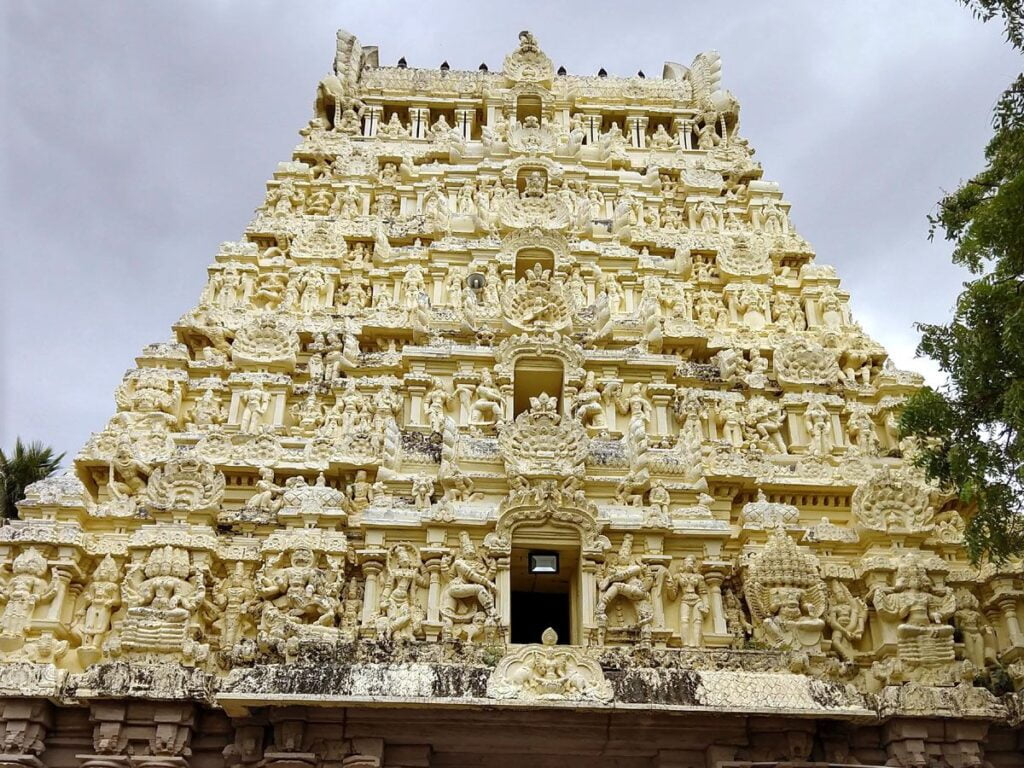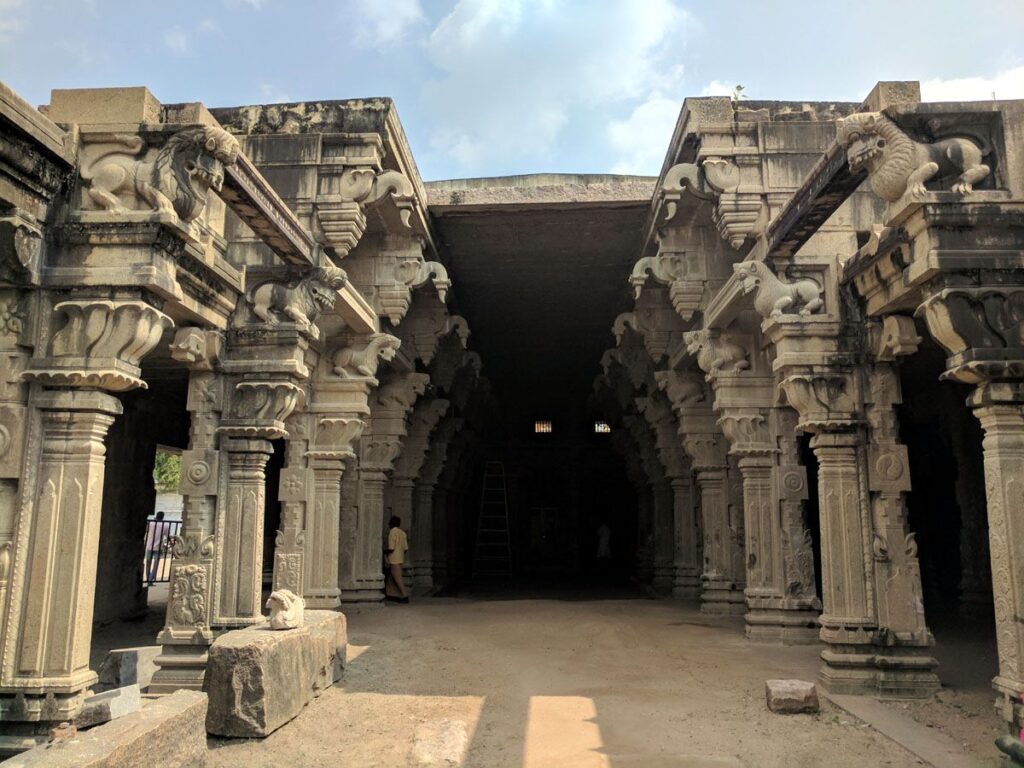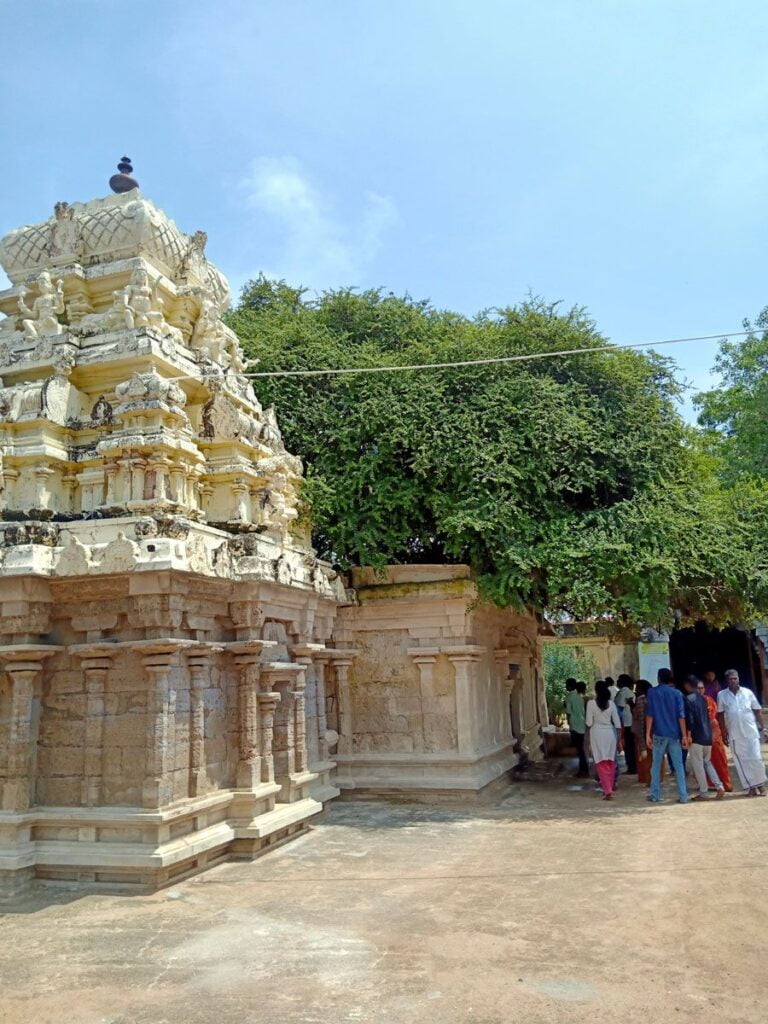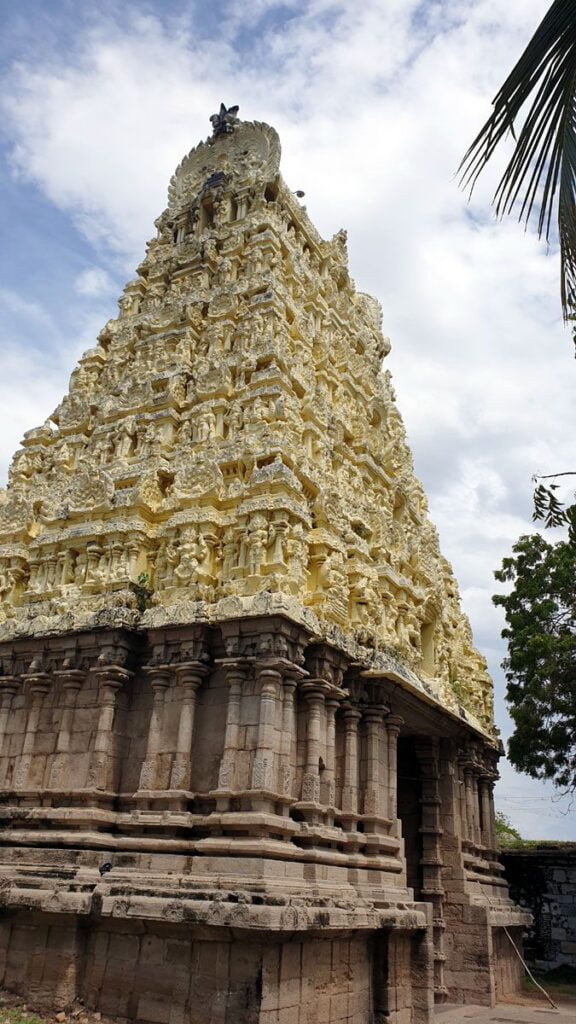Uthirakosamangai Temple of Arulmigu Mangaleswari Udanurai Mangalanatha Swamy
Uthirakosamangai Temple, also known as Mangalanathaswamy Temple, is a Hindu temple dedicated to the god Shiva located in the Ramanathapuram district of Tamil Nadu, India. The temple is one of the oldest Shiva temples in the world, with a history dating back to 3,000 years.

Contents
- 1 History of Uthirakosamangai Temple:
- 2 Legend of Uthirakosamangai Temple:
- 3 Myths and Beliefs associated with Uthirakosamangai Temple:
- 4 Architecture of Uthirakosamangai Temple:
- 5 Significance of Uthirakosamangai Temple:
- 6 Uthirakosamangai Temple Timing and Rituals:
- 7 Places to visit near Uthirakosamangai Temple:
- 8 FAQ:
- 9 How to reach Uthirakosamangai Temple:
- 10 Google Maps:
History of Uthirakosamangai Temple:
The temple has been mentioned in several ancient texts, including the Mahabharata and the Ramayana. The Mahabharata mentions that the Pandavas visited the temple after their exile. The Ramayana mentions that the sage Agastya visited the temple and performed a yajna.
The temple has been renovated several times over the centuries. The most recent renovation was completed in 1992. The temple is a popular pilgrimage destination for Hindus from all over India.
The temple is divided into three main sections: the outer prakara, the inner prakara, and the sanctum sanctorum. The outer prakara is surrounded by a wall and contains several shrines dedicated to other Hindu deities. The inner prakara is also surrounded by a wall and contains the shrines of Mangalanathar, Mangalambigai, and other deities. The sanctum sanctorum is located at the center of the temple and houses the images of Mangalanathar and Mangalambigai.
The temple is known for its beautiful architecture and sculptures. The walls of the temple are decorated with intricate carvings of Hindu deities and scenes from Hindu mythology. The temple also has a number of well-preserved inscriptions, which date back to the 9th century CE.
Read More>> 600 yrs Old Ghati Subramanya Temple

Legend of Uthirakosamangai Temple:
According to the legend, Mandothari, the wife of the demon king Ravana, was a devout worshipper of Lord Shiva. She wanted to marry the most devoted Shiva worshipper in the world, so she performed a rigorous penance.
Lord Shiva was impressed by Mandothari’s devotion and decided to grant her wish. He appeared in the form of a small child and entered Ravana’s palace. Ravana was overjoyed to have a son and showered the child with love and affection.
One day, Ravana was playing with the child when he accidentally touched the child’s feet. The child immediately transformed into Lord Shiva, who was furious at Ravana’s disrespect. He unleashed his fiery wrath, setting the entire world ablaze.
The sages, who were entrusted with the sacred scriptures, were terrified of Lord Shiva’s wrath. They threw themselves into a sacred pool, which came to be known as “Agni Theertham.”
Only one sage, Manikavasagar, had the courage to stand up to Lord Shiva. He saved the sacred scriptures and handed them over to Lord Shiva.
Lord Shiva was impressed by Manikavasagar’s devotion and courage. He forgave Ravana and blessed the marriage of Ravana and Mandothari. He also blessed Manikavasagar with his own lingam form.
The Uthirakosamangai Temple is dedicated to Lord Mangalanathar, the form of Lord Shiva that appeared to Mandothari. The temple is located in the Ramanathapuram district of Tamil Nadu, India.
The temple is believed to be one of the oldest Shiva temples in the world. It is said to have been built by the Pandavas, the heroes of the Mahabharata.
Read More>> Ganagapur Dattatreya Temple Karnataka

Myths and Beliefs associated with Uthirakosamangai Temple:
1. Origin of the Name:
- The name “Uthirakosamangai” has a beautiful mythological meaning. “Uthira” means “upadesam” (teaching), “Kosam” means “rahasyam” (secret), and “Mangai” is another name for Parvati, the consort of Lord Shiva.
- According to legend, this is the place where Lord Shiva revealed the secret knowledge of the Vedas to Parvati. This sacred act of imparting divine knowledge earned the temple its name.
2. The Legend of Mandothari:
- Mandothari, the wife of Ravana, the demon king, is believed to have played a significant role in the temple’s history.
- Legends say that Mandothari, seeking refuge from her husband’s wrath, came to Uthirakosamangai and prayed to Lord Shiva for protection. Pleased by her devotion, Shiva granted her wish and hid her within the Uthirakosamangai Temple walls.
- Some versions of the myth claim that Mandothari even helped construct the temple.
- Inscriptions on the temple walls mentioning Mandothari’s name lend credence to these legends.
3. The Dispute Between Vishnu and Brahma:
- Another fascinating myth associated with the Uthirakosamangai Temple involves the eternal rivalry between Lord Vishnu and Lord Brahma.
- The story goes that both Vishnu and Brahma once engaged in a heated debate about who was superior. To settle the dispute, Lord Shiva appeared before them as a massive, unending pillar of fire.
- He challenged them to find the source of the fire, declaring that whoever reached the end first would be deemed the greater god.
- Vishnu, accepting his limitations, readily conceded defeat. Brahma, however, took the form of a swan and flew upwards in search of the fire’s peak.
- As Brahma ascended, a flower called “Thozhambi” fell from his head and landed near the base of the fire. Mistaking it for the fire’s source, Brahma returned to Shiva and declared his victory.
- Shiva, knowing Brahma’s lie, exposed his deceit and reaffirmed Vishnu’s humility and honesty.
4. The Sacred Emerald Nataraja:
- The Uthirakosamangai Temple is renowned for its exquisite emerald statue of Lord Nataraja, the cosmic dancer.
- This captivating idol is believed to be extremely delicate and sensitive to vibrations.
- As a result, no percussion instruments are used during temple rituals to avoid accidentally damaging the statue.
- The emerald Nataraja is adorned with sandal paste throughout the year, except for the auspicious “Thiruvathidirai” festival day, when special rituals are performed.
5. The Lingams of Padigam:
- The temple’s front hall houses several unique lingams made of “Padigam” (crystal).
- These lingams are anointed with cooked rice every afternoon as part of the temple’s daily rituals.
- This practice is believed to be highly auspicious and is said to bring prosperity and blessings to devotees.
Read More>> Shankaracharya Temple | Jyeshteshwara Temple

Architecture of Uthirakosamangai Temple:
The Uthirakosamangai Temple, dedicated to Lord Shiva in Tamil Nadu, India, boasts a captivating architectural style that blends Dravidian and Chola influences. Here’s a closer look at its key elements:
Dominant Gopuram:
- The temple’s most striking feature is its seven-tiered gopuram (gateway tower), adorned with intricate sculptures and vibrant colors.
- The gopuram stands as a majestic entrance, beckoning devotees into the temple’s sacred grounds.
Sculptural Splendor:
- Uthirakosamangai Temple walls are adorned with exquisite sculptures depicting various Hindu deities, mythical creatures, and scenes from epics like Ramayana.
- These sculptures are not just decorative; they narrate stories, convey spiritual messages, and add depth to the temple’s atmosphere.
Multiple Shrines:
- The temple complex houses several shrines, each dedicated to a specific deity.
- The most prominent shrines are those of Mangalanathar (Shiva) in the form of a lingam (aniconic representation), Mangalambigai (Parvati), and Nataraja (cosmic dancer).
- Each shrine has its own unique architectural design and ornamentation, reflecting the specific deity’s significance.
Emerald Marvel:
- Uthirakosamangai Temple houses a 6-foot-tall emerald idol of Nataraja, believed to be one of its kind.
- This magnificent sculpture is covered with sandalwood paste for most of the year, except during the month of January when it is unveiled for a special darshan (viewing).
Additional Architectural Elements:
- The temple complex also features a hall of Sahasralingam, housing a thousand lingams, and a dedicated sanctum for Manickavasagar, a renowned Tamil poet and devotee of Shiva.
- The temple’s courtyards are spacious and serene, providing a sense of peace and tranquility for worshippers.
Read More>> 10th CE Chakrapani Temple Kumbakonam

Significance of Uthirakosamangai Temple:
The Uthirakosamangai Temple holds immense significance for Hindus on several levels:
Religious:
- Ancient lineage: Believed to be one of the earliest Shiva temples in the world, with claims going back 3,000 years.
- Spiritual center: Home to the priceless emerald statue of Sage Mangaleswarar and a rare, self-made lingam.
- Unique practices:
- Only place where the “thalamboo” flower, forbidden in most Shiva temples, is used in worship.
- Natarajar idol kept covered in sandalwood paste for 11 months, revealing it just for Markazhi Thiruvathirai day.
- Birthplace of deities: Legend claims it as the birthplace of Lord Shiva and Parvathi.
- Sacred secrets: Uthirakosamangai means “secret instruction in northern direction,” referring to Lord Shiva teaching Parvathi the Vedas here.
Historical:
- Literary mentions: Found in various ancient scripts and Saivite canons.
- Pandya patronage: Major renovations by Pandya kings.
- Legends: Linked to stories of Mandothari (Ravan’s wife) and Lord Shiva’s sacred scripture.
Symbolic:
- Harmony of cosmic bodies: Said to have been established when only Sun, Moon, and Mars existed.
- Unity of couple: Worshipping at the Uma Maheswarar shrine is believed to strengthen marital bonds.
- Significance of nature: Sacred tree estimated to be 3,000 years old.
Local importance:
- Considered sacred alongside major pilgrimage sites like Ramanathapuram, Sethu Madhava Theertham, and Lakshmana Theertham.
- Major attraction for tourists and devotees seeking spiritual experiences.
Read More>> Rudranath Temple: The Ultimate Guide
Uthirakosamangai Temple Timing and Rituals:
The temple is open to the public from 5:00 AM to 12:00 PM and from 4:00 PM to 8:00 PM. The main rituals performed at the temple are:
- Abhishekam: Abhishekam is a ritual in which the deity is bathed with holy water. This ritual is performed twice a day, in the morning and evening.
- Nitya Kalyanam: Nitya Kalyanam is a ritual in which the deity is ceremonially married. This ritual is performed every day at noon.
- Usha Pooja: Usha Pooja is a ritual performed in the morning to welcome the goddess. This ritual is performed at 5:00 AM.
- Sandhya Vandanam: Sandhya Vandanam is a ritual performed in the evening to bid farewell to the goddess. This ritual is performed at 6:00 PM.
Read More>> Vijayawada Kanaka Durga Temple: A Beacon of Hope & Strength
Places to visit near Uthirakosamangai Temple:
- Rameswaram: One of the holiest places for Hindus, Rameswaram is known for the Ramanathaswamy Temple, which is one of the Char Dham pilgrimage sites. It’s about 71 kilometers from Uthirakosamangai.
- Dhanushkodi: Located on the southeastern tip of Pamban Island, Dhanushkodi is known for its pristine beaches and the Adam’s Bridge or Rama Setu. It’s about 82 kilometers from Uthirakosamangai.
- Kothandaramaswamy Temple: This temple is believed to be the place where Lord Rama crowned Vibhishana as the king of Lanka. It’s located in Dhanushkodi.
- Agniteertham: A sacred beach in Rameswaram where pilgrims take a holy dip. It is believed to cleanse sins.
- A.P.J. Abdul Kalam Memorial: Pay homage to the former President of India, Dr. A.P.J. Abdul Kalam, at his memorial in Rameswaram.
- Ramar Patham: A sacred site associated with Lord Rama, located in Rameswaram.
- Gandhamadhana Parvatham: This hillock in Rameswaram offers panoramic views of the island and is believed to be the place where Lord Rama stood and directed Hanuman to bring the medicinal herbs.
- Devipattinam: About 38 kilometers from Uthirakosamangai, this coastal town is known for its Navagraha temples and is associated with the Hindu epic Ramayana.
- Mandapam: A town located near Rameswaram known for its beautiful beaches.
- Pamban Bridge: Visit the famous Pamban Bridge, which connects the town of Rameswaram to the mainland. It’s a historic and engineering marvel.
FAQ:
What is Uthirakosamangai Temple?
Uthirakosamangai Temple is a Hindu temple dedicated to the god Shiva. It is located in the town of Uthirakosamangai, Tamil Nadu, India. The temple is believed to have been built by the Chola dynasty in the 10th century.
What are the main deities worshipped in the temple?
The main deities worshipped in the temple are Shiva, Parvati, and Murugan. Shiva is worshipped as Nataraja, the cosmic dancer. Parvati is worshipped as Umai. Murugan is worshipped as Skanda.
What are the main festivals celebrated in the temple?
The main festivals celebrated in the Uthirakosamangai Temple are:
- Mahashivaratri: This festival is celebrated in February or March to commemorate the wedding of Shiva and Parvati.
- Aadi Thirumangazhai: This festival is celebrated in July or August to commemorate the wedding of Shiva and Umai.
- Skanda Shasti: This festival is celebrated in November or December to commemorate the victory of Murugan over the demon Surapadman.
What are the special features of the temple?
The temple is known for its beautiful architecture and sculptures. The Nataraja statue in the temple is one of the most famous Nataraja statues in India. The statue is made of emerald and is said to have been brought to the temple by the Chola king Rajendra Chola I.
What are the visiting hours of the temple?
The Uthirakosamangai Temple is open to the public from 6:00 am to 12:00 pm and from 4:00 pm to 8:00 pm.
How to reach Uthirakosamangai Temple?
Uthirakosamangai is located about 100 kilometers from the city of Madurai. The best way to reach the temple is by car or bus. There are also trains that run between Madurai and Uthirakosamangai.
What are the must-do things in Uthirakosamangai?
In addition to visiting the temple, visitors can also enjoy the following activities in Uthirakosamangai:
- Visit the nearby town of Madurai, which is home to many other temples and historical sites.
- Take a boat ride on the Vaigai River, which flows through Uthirakosamangai.
- Visit the nearby villages, which are known for their traditional Tamil culture.
How to reach Uthirakosamangai Temple:
By Air: The nearest airport is Madurai International Airport (IXM), which is well-connected to major cities in India. From Madurai, you can hire a taxi or use public transportation to reach Ramanathapuram and then proceed to Uthirakosamangai.
By Train: The nearest major railway station is Ramanathapuram Railway Station. From the railway station, you can hire a taxi or use local transportation to reach Uthirakosamangai Temple.
By Road:
- From Ramanathapuram: Uthirakosamangai Temple is about 18 kilometers south of Ramanathapuram. You can take a taxi or use local buses to reach the temple.
- From Madurai: If you are coming from Madurai, you can reach Ramanathapuram first and then follow the directions mentioned above.
- By Bus: Regular bus services operate from nearby towns and cities to Ramanathapuram. Once you reach Ramanathapuram, you can take a local bus or hire a taxi to reach Uthirakosamangai.
